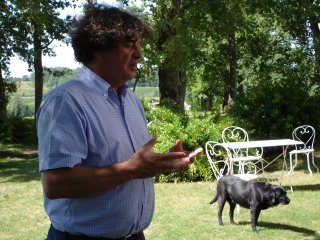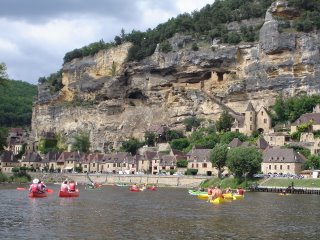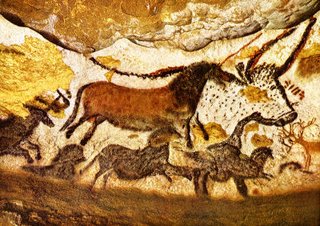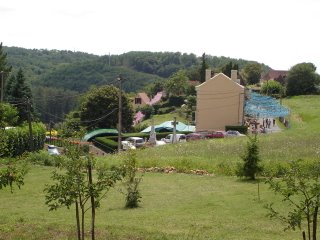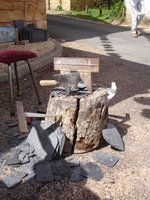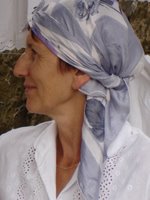
One of the greatest pleasures of living right on the river, is to have the company of anything up to 140 swans right outside my window. To walk out onto the terrace with a few pieces of bread and have the swans immediately come swimming closer the moment they see me, knowing that a tasty titbit awaits them, is a wonderful experience.
Over the last year that I have been here, I have watched from my window how little families grow - from when the small brown chicks stay so close to their parents that you hardly know they are there until the young ones are the same size as their parents and can only be recognised by their slightly dun coloured neck feathers or their slightly more orange beaks, and then they set off to wherever they had decided to spend their winter. After winter they all came back, and judging from those that came straight to the foot of the chateau to see if I still dished out bread, I knew that some of them had to have been the offspring I had watched being born, grow and develop.
However, this year there is something strange afoot. None of the pairs are breeding. There are no little families on the river this year. No cygnets. No parents solicitously looking after their young, teaching them where to graze, which currents to look out for, what to do when the river suddenly takes them downstream.In fact, the only baby swans I have seen were three, almost fully grown, with their parents, near Beynac, the day we went canoeing.
Where are the baby swans this year? Why no breeding? Is this a sign of an early winter or an exceptionally cold one? -- the temperatures are most definitely pointing in that direction. These lows of 12' - 14' during the month of August are exceptional and yet another indication of the changing seasons. I was wondering whether this is similar to the squirrels in the United Kingdom indicating cold harsh winters when they start collecting nuts and berries early on in the summer. --- or is that another old wive's tale?
In trying to research the subject, I could find no information -- perhaps one of our readers knows more and can inform us? -- but what I did come across is a fascinating account of the Cygnet Cult -- which originates in Ireland.

The Cygnus Mystery
Why exactly the cult of the swan might have existed in megalithic Ireland, and indeed among several other key Neolithic stone monuments in the British Isles, is not clear. Avebury, Wayland Smithy long barrow and Callanish are all aligned towards either the rising or setting of key stars in the celestial swan, which since Palaeolithic times has been seen as a primary symbol of the cult of dead and rebirth across Europe and Asia.
 Indeed, as a psychopomp (Greek for 'soul-carrier'), the celestial bird was universally considered the vehicle by which the dead were able to reach a northerly placed heaven 'north beyond the north wind', a belief that prevailed in the Scottish Western Isles until very recently. Moreover, such beliefs in Europe go back at least to 4800 BC, since a Mesolithic burial unearthed recently in Denmark was found to contain a woman and her young child, who had been laid to rest on a giant swan's wing. Indeed, it moved prehistorian and Palaeolithic expert Steven Mithen to comment:
Indeed, as a psychopomp (Greek for 'soul-carrier'), the celestial bird was universally considered the vehicle by which the dead were able to reach a northerly placed heaven 'north beyond the north wind', a belief that prevailed in the Scottish Western Isles until very recently. Moreover, such beliefs in Europe go back at least to 4800 BC, since a Mesolithic burial unearthed recently in Denmark was found to contain a woman and her young child, who had been laid to rest on a giant swan's wing. Indeed, it moved prehistorian and Palaeolithic expert Steven Mithen to comment:Among the nineteenth-century Saami people of northern Europe, swans and wildfowl were the messengers of the gods. Such birds could, after all, walk on the land, swim on the water and fly in the air - adept at moving between different worlds. Perhaps the Mesolithic people had similarly revered their swans and let one fly that poor child away to their afterworld where he could have the life denied to him on earth. (Mithen, AFTER THE ICE, pp.181-2)

The cult of Cygnus is integrally related to the shamanic process of entering the sky-world (heaven if you like) via a perceived sky-pole that terminates in something known to mythologists as the cosmic axis, synonymous with the north celestial pole. This is marked in the night sky by the Pole Star, or North Star, currently Polaris in Ursa Minor, although this is simply the latest in a series of pole stars which feature during the Earth's 26,000-year precessional cycle. As the perceived guardian of the entrance to the sky-world, Cygnus as the cosmic bird, positioned at the most northerly extent of the Milky Way, is at the heart of ancient cosmologies and religions worldwide. It has been a major influence on the design and orientation of sacred architecture, which, in addition to the megalithic monuments of Britain and Ireland, includes the Pyramids of Giza, the ancient effigy mounds of the United States, as well as various ancient temples in Mexico, Peru and India.
Cygnus is also at the root of Christianity's use of the Crucifix as a symbol of death and redemption, as well as the veneration of the north as the direction of the Primal Cause, God himself. This belief is found within the religions of various Middle Eastern sects descended from the star-worshipping Sabians of Harran (known as the Chaldeans in the Bible). They include the angel-worshipping Yezidi of Syria and Upper Iraq, the Mandaeans of Iraq and Iran, and the Shi'i Muslim sect called the Brethren of Purity.
What with discovering ley lines and dowsing and ancient Celtic sacrificial stones, my readers will start wondering whether the mist over the river in the mornings, or the feast of Celtic music I have been listening to, or the woodsmoke that drifts into my window every morning from my neighbour's garden might be starting to affect me!
But fear not! I am simply on a quest to find out why the swans are not breeding this year on the Dordogne!

Click on Link:
Chateau Lalinde : The perfect venue for your event
TAGS: Events Rent a chateau France
Chateau
Perigord Food Holidays in France Recipes


